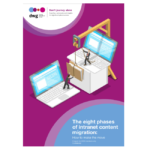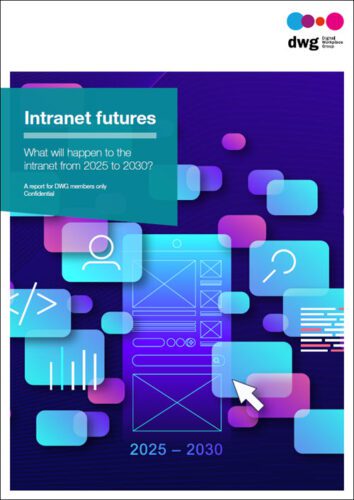What digital workplace practitioners can learn from the Tech for Good movement

If you’re involved in the Tech for Good movement in any way, even if it’s “just” following #techforgood on Twitter, you will have come across a name that is very familiar in the digital workplace world, both to those involved with DWG and to those who follow Digital Nations Group: Paul Miller. While the “DWG Paul Miller” has been at the forefront of pushing digital workplace thinking and how we use technology for work, there is an “other Paul Miller” that has been at the forefront of how we use technology in a different field (to avoid any confusion, the “other Paul Miller“ will henceforth be referred to as “Mr Miller”).
The start and growth of the Tech for Good movement
Mr Miller was involved in setting up the first Social Innovation Camp hackathon one weekend in April 2008, located in Bethnal Green, east London. The intention was to provide a shared space, time, post-its and WiFi (and crucially also lasagne) for developers and designers who were involved in the “Silicon Roundabout” start-up boom, and also for public servants, experts, academics and ordinary people who had first-hand experience of public services. The goal: to enable collaboration between these groups of people to work on “stuff that matters”.
This turned out to be the first Tech for Good Meetup, an initiative that is still going strong today and has over 8,800 members. And it turned out to be the genesis of a movement of the same name.
A recent report has found that the UK has since become the “global centre for socially responsible technology innovation”, with for-profit organizations that can be identified as “tech for good” companies coming in at a value of £2.3 billion in 2018, with a turnover of £732 million. Meanwhile, social impact investors, such as Bethnal Green Ventures (of which Mr Miller is Managing Partner and CEO), raise funds to support teams who want to launch and scale their tech for good solutions. There are organizations focused on govtech, edtech, fintech, agritech, and much, much more.
Away from the UK, the last few years have also seen the emergence of public interest technology in the US and there are more than 1,400 projects across Europe focused on tech for good causes. Charities and non-profits are increasingly looking at how they can harness technology to help them address their causes. And the trend is repeated across the world, with people turning their technological nous to solving the challenges being faced by our societies, considering everything from “low-hanging fruit” to some of the more wicked problems.
What is “tech for good”?
As with any movement, the understanding of what “tech for good” actually is can vary depending on who you’re talking to. But at its heart, it seems to have evolved to a place where the term can be used to refer to:
- A community focused on advocating the role of technology in improving social outcomes.
- Designing and developing technological solutions that address social, economic and environmental challenges.
- Building these technological solutions in collaboration with those for whom the technology is intended, and who will be impacted by it – in ways and with end results that are ethically conscientious.
This final point – ensuring that the creation process as well as the end product are both “good” – is one that is relatively new for the movement, and which is well described by Cassie Robinson, former Strategic Design Director at doteveryone:
“Because 2018 really was the year of tech for bad and there was a realisation that technologies change at speed and are changing our society at speed, conversations about the applications of technology became inextricably linked with the implications of technology. The tech for good community started paying attention to how tech is created as well as how it is used and the purpose it has.”
It reminds me of a key point that Dianna Langley made when sharing Oxfam International’s digital workplace on DW24 2019: it was essential to the team to make sure they were taking what they termed a “rights-based approach” to their work. This meant respecting and protecting the rights of the people who would be using the technology, such as their data rights, privacy, and making sure they felt safe using the platforms.
How can the tech for good movement inspire our approach to digital workplaces?
Here at DWG we are currently moving towards considering work and our relationship with it more as a living ecology and ecosystem. As we do so, a piece by Cassie Robinson entitled Putting users first is not the answer to everything strikes a chord, also forming part of a wider conversation that is emerging about rewriting the way in which a key tenant of tech for good is approached: user-centred design.
Cassie argues that putting the individual’s needs at the centre of our design process can ignore the needs of the system, in which that individual is just one element. In other words, that individual doesn’t exist in a vacuum; they have their own individual needs, but there are also the collective needs of the community around them, and then wider societal needs as well.
It’s a useful reminder for digital workplace practitioners that our solutions touch not just the individual person (“I”), but also teams, departments, different interest groups, the organization as a whole (“we”), and even wider – customers, clients, suppliers, families of colleagues and more (“they”), all of whom are impacted in some way by our design choices .
What else? The website techforgood.global sets out 10 key principles, which can help us think through as digital workplace practitioners if our approaches and solutions are intentionally “for good”. What will their impact be on not only on our colleagues, but their teams, relationships, the organization itself and different communities? What choices are we making with the digital workplace technologies we purchase?
And so here are some ideas on how we as the digital workplace community can fold in a tech for good mindset into our work, inspired by some of those 10 principles:
- “Tech for who?” Are we designing for everyone? Is it usable by the many within our organizations? This works as a reminder not to just focus on, for example, HQ, but also those in the field and those who aren’t immediately visible to us.
- “Has it been designed responsibly?” Are we taking into consideration issues around privacy and data? Are we thinking about security? Are we following, as Dianna Langley says, a rights-based approach?
- “Does it give power and agency to people?” Is it helping people to transform the way they work in a way that helps give them more agency? For example, this could be through flexible working, or access to vital information and services as and when they’re needed.
- “It doesn’t have to be about the new” Can we find new contexts and applications for our current solutions, instead of always seeking out new solutions?
- “How’s it made?” Are we aware of – and documenting – how the technologies and hardware we’re using are made?
- “Have you thought about assisted digital needs and access?” Accessibility can all too frequently be forgotten or tacked onto the end of our work. As organizations seek to make their workforces more diverse, are they ensuring the tools being created can be used by everyone, including those with assisted digital needs?
- “Are the people who created it aware of any unintended consequences?” Flexible and remote working are amazing, empowering implications of mobile and cloud-based technology. What isn’t amazing is feeling you need to be checking your emails at 2am when your phone notifications ping. Are we – and our organizations – thinking through and listening out for any unintended consequences of our digital workplaces and ways of working, and prepared to mitigate against these?
Are you already doing some of these things? Are there areas you feel could be improved? Share below on how your team is helping to create its own “digital workplace for good”.
Other resources in the Digital Nations Series:
- Blog: Why improving the digital literacy of citizens is crucial for both the digital nation and the future of work
- Upcoming event: My city, my office – the rise of urban mobile working
- Podcast: What universities can teach digital workplace people
- Podcast: How the World Bank digitally empowers the young in developing nations
Take the next step…
Categorised in: Digital workplace practitioners

